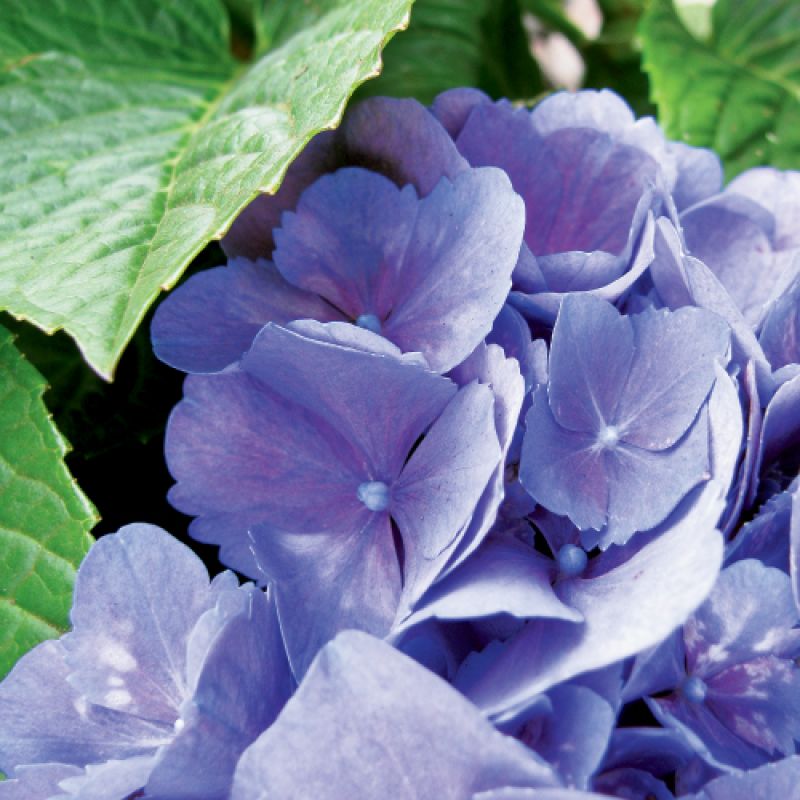
Come summertime, hydrangeas are the Southern cottage garden favorite. These easy-to-grow shrubs are prized for their big, showy clusters of flowers that brighten up shady garden beds with hues of blue, pink, and white. These blooms make an excellent cut flower that can last for weeks in an arrangement or be dried to enjoy throughout the year (see sidebar). Best of all, they come in hundreds of varieties—from the popular mopheads and lacecaps to the native oakleafs—suiting most all landscape conditions and styles.
Big-leaf hydrangea (H. macrophylla)
Big-leaf cultivars have two flower types: the globe-shaped mophead and the disc-shaped lacecap. Most are pH sensitive, allowing gardeners to change the petal color by adjusting the soil. Acidic soil (pH below 7) produces cooler blue hues, while alkaline soil (pH above 7) offers warmer pinks. This deciduous shrub will need room to grow, reaching three to six feet tall and equally as wide.
H. macrophylla ‘Ayesha’
This less common mophead emits a delicate fragrance from its slightly cupped petals that are reminiscent of a succulent. ‘Ayesha’ will bloom on the growth of the previous season, referred to as “old wood.”
Hardiness: Zones 6-9
Light: Morning sun and afternoon filtered light
Soil: Well-draining
Water: Check daily until established, then reduce and water weekly or as needed.
Maintain: Prune to manage size after it blooms.
H. macrophylla ‘Fuji Waterfall’
This lacecap produces gorgeous, cascading double blooms that set it apart from the more common upright versions. It can grow to five feet in height and width.
Hardiness: Zones 6-9
Light: Partial shade
Soil: Well-draining
Water: Check daily until established, then reduce and water weekly or as needed.
Fertilize: Apply 10-10-10 every seven to eight weeks in the spring.
Maintain: Prune to manage size after it blooms but before August 1.
Oakleaf hydrangea (H. quercifolia)
This native beauty gets its name from its unique oak-leaf-shaped foliage. It is a great option in sunnier spots and can grow into a large shrub, reaching six to eight feet in height. Oakleaf hydrangeas produce striking white pyramid-shaped blooms in the summer that turn to warm red hues for a second show of color in the fall.
H. quercifolia ‘Gatsby Star’
If space is a limitation, check out this new 2014 release from the Proven Winner line. It has a compact habit that reaches five to six feet in height and can be easily pruned to keep in scale. ‘Gatsby Star’ will produce white double blooms that are said to reach 12 to 16 inches in length. Come fall, its foliage turns a beautiful deep burgundy.
Hardiness: Zones 5a-9b
Light: Sun to partial shade
Soil: Well-draining, loamy
Water: Check daily until established, then reduce to weekly watering or as needed.
Fertilize: Apply 10-10-10 every seven to eight weeks in the spring.
How to Dry Hydrangeas
➼ Select blooms when the season is nearing its end and all flowers have opened fully with the colors just beginning to fade.
➼ Cut at least 12 to 18 inches from the base of the flower head.
➼ Strip leaves from the stems and move the cut flowers into a container filled with clean water. The stems should be submerged at least halfway.
➼ Place in a well-ventilated, dry area away from direct sunlight.
➼ Wait until the water has evaporated entirely from the vase. When no liquid remains, the blooms are dry and can be used in arrangements, wreaths, or craft projects.